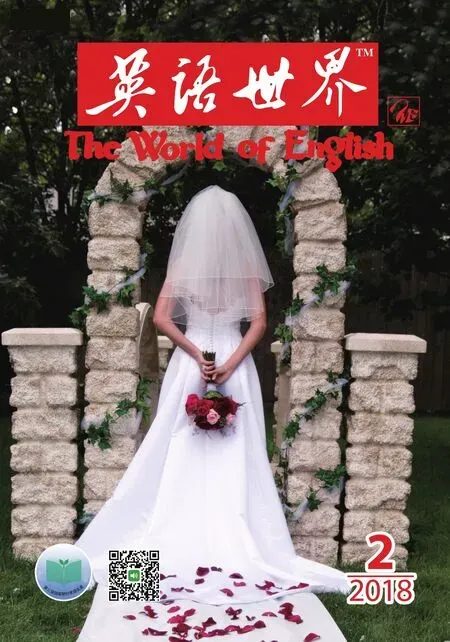18 National Tying-the-Knot1 Traditions from Countries Across the Globe
By Corey Whelan
From the customary father-daughter dance to wearing something old, something new, something borrowed, and something blue2起源于西方的婚礼习俗,新娘在结婚当天需要穿戴“有旧、有新、有借和有蓝”的四件服饰,四件东西各有含义,传说能带来吉祥和财富。, weddings are filled with tradition. Whether the tradition is a long-standing family ritual or merely for a little good luck, it’s comforting to know that you are carrying on something of familial or cultural significance.从新娘和父亲共舞,到穿戴“有旧、有新、有借和有蓝”的服饰,婚礼中的传统无处不在。无论这些传统是累世家传的仪式,还是只为求得些许好运,可感欣慰的是,家族传统和文化价值由此得以延续。

Dancing feet
Origin: Ireland
During traditional Irish weddings, the bride had to keep at least one foot on the ground at all times while dancing. If both feet left the floor at the same time,legend had it that fairies would swoop3swoop飞降;俯冲。under the bride and carry her away.
跳舞时双脚不能同时离地
起源地:爱尔兰
在爱尔兰人的传统婚礼上,新娘在跳舞的时候,至少得有一只脚落在地面。如果双脚同时离开地面,传说会有妖精冲到新娘脚下,将其掳走。
Lovespoons
Origin: Wales
Originally these were hand carved by young men in order to court women.The spoons were given to a man’s lady of interest to court her and express his desire to feed and support her. Now lovespoons are often exchanged on a couple’s wedding day to commemorate their love.
Blackening of the bride and groom
Origin: Scotland
This originated as a practice to ward off evil spirits and bring good luck before marriage. The bride and/or groom is captured by friends and family the day before the wedding and covered in soot4soot煤烟灰。, mud, flour, feathers, and other sticky substances, and loudly paraded around town. Sometimes the victim ends up tied to a tree or post, or thrown in a body of water.
Baumstamm sägen (sawing the log)
Origin: Germany
The idea of a kidnapped bride may be terrifying for a groom-to-be, but this German tradition is all fun and games.The night before the wedding, the bride is taken away by family and friends and hidden at a local pub. The groom must visit various bars to find his bride (buying drinks along the way) and once he finds her, he must pay her ransom by buying a round of drinks or performing romantic gestures.
爱情匙
起源地:威尔士
爱情匙最初是年轻男子自己手工雕刻而成的木制羹匙,用来向女性求爱。男子把爱情匙送给心仪的女性,表达自己愿意养活和照顾她的心意。现在,新郎新娘通常在婚礼当天交换爱情匙,作为对他们爱情的纪念。
涂黑新郎和新娘
起源地:苏格兰
这种习俗最初是为了在结婚前替新郎新娘祛邪祈福。在婚礼前一天,亲友们抓住新郎和/或新娘,在他们身上涂满煤灰、泥巴、面粉、羽毛以及其他黏黏的东西,再大张旗鼓地带着他们满城游行。新郎新娘最后可能被绑在树上或柱子上,也可能被扔进水池里。
锯圆木
起源地:德国
对新郎来说,新娘被绑架可能是个恐怖的想法,但德国人的这个传统却充满游戏之乐。婚礼前一天晚上,亲友们会把新娘带走藏在当地某间酒吧。新郎需要到各个酒吧找他的新娘(一路都要请酒吧里的人喝酒)。找到新娘后,新郎还需要有所表示才能赎回新娘,要么请酒吧里所有人喝酒,要么当众做出一些浪漫的举动。
After the ceremony, the bride and groom have to use a two-person crosscut handsaw to cut a large log in half—while still in their bridal clothes! This symbolizes the ways in which they must work together in the future (although, to make it a bit quicker,the log has sometimes already been partially sawed through by the fathers of the bride and groom).
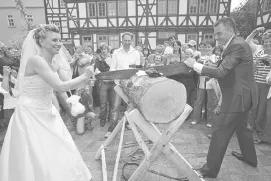
Dancing till dawn
Origin: France
Joyful, weekend-long French weddings bring new meaning to the phrase,“dancing the night away.” French weddings feature non-stop dancing all night long, which doesn’t stop until the guests fall down, or it’s time to go to work. French marriages must have a civil ceremony, in order to be legal,so French brides and grooms often opt for two events over a long weekend—one civil service, and one religious ceremony. Either or both may be followed by a fabulous, champagne-filled fete,complete with a disc jockey5又称“唱片骑师”,是指选择并且播放事先录好的音乐来为他人带来娱乐的人。, band, and foot-tapping rhythms that keep guests on their feet for seven hours, or more.
婚礼仪式结束后,新郎新娘还得用一把双人横锯,把一根大圆木锯成两半——那会儿他们还穿着礼服呢!锯圆木的习俗象征着新郎新娘在未来的生活中必须同心协力。当然,为了节省时间,新郎的父亲和新娘的父亲有时会事先把圆木锯开一截。
跳舞到天明
起源地:法国
法国人通常选在周末两天举行婚礼,欢乐的法国婚礼给“跳到夜色消散”这句话带来了新的注解。法国婚礼的一大特色就是彻夜不停地跳舞,一直跳到客人精疲力竭,或跳到第二天该去上班为止。在法国,结婚必须要在政府登记注册才算合法。所以法国新郎新娘通常选在长周末举办两场婚礼仪式——一场注册登记,一场宗教仪式。每场仪式后,都可能举行盛大的香槟宴会。宴会上会有调音师、乐队和节奏感强的音乐,客人们跳舞往往能跳上七个小时,有时还会跳得更久。
Kissing the newlyweds
Origin: Sweden
Newlyweds in Sweden may be kissing more than each other on their wedding night. If the bride leaves the room for any reason, other women are allowed to kiss the groom. Same goes if the groom leaves the room for any reason.
Unity bowl
Origin: Australia
Guests are given stones or marbles to hold throughout the wedding. At the end of the ceremony the stones are placed in the unity bowl, which the couple will take home as a reminder of their friends’and families’ support. Sometimes different colored stones are given to each generation, and stones are placed in the bowl from oldest to youngest to build a strong foundation for the couple.
Kransekake (a special kind of cake)
Origin: Norway
Norwegians don’t have the threetiered wedding cake. Instead, they make Kransekake6挪威的传统节日蛋糕甜点,用冰冻的杏仁奶油蛋糕圈装饰起来的锥形蛋糕塔,通常做成超过葡萄酒瓶高度的宝塔状,以便宾客分食。, a steep-sided cake cone made by sticking rings of cake on top of one another with icing (often 18 rings or more). At the wedding, the bridal couple tries to break off the top layer—the number of cake rings that stick to it represent the number of children the couple will have!
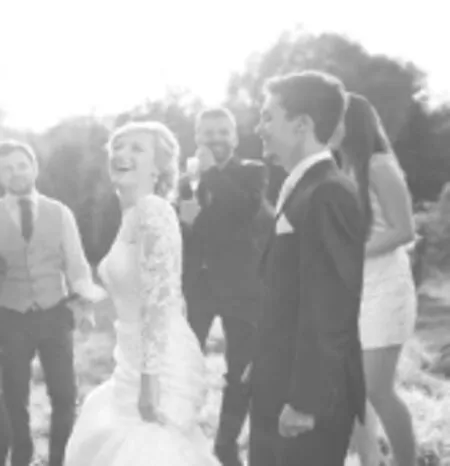
亲吻新婚夫妇
起源地:瑞典
在瑞典,新婚夫妇在婚礼当晚可能会被对方以外的人亲吻。不管出于什么原因,只要新娘离开房间,其他女性都可以亲吻新郎。新郎走开后也是一样,其他男性都可以亲吻新娘。
同心碗
起源地:澳大利亚
参加婚礼的客人们每人会领到一小块石头,在整个婚礼仪式上都要拿着它。仪式结束时,这些石块被放进同心碗中。新婚夫妇把装满石块的同心碗带回家中保存,留作对亲友支持的纪念。有时候,不同辈分的客人领到的石块的颜色也不同。客人们依照从长到幼的次序,把石块放进同心碗中,有给新婚夫妇的生活打下坚实基础的寓意。
圈塔蛋糕
起源地:挪威
挪威人的婚礼上没有三层婚礼蛋糕。他们会做“圈塔蛋糕”。这是一种用饼圈从大到小层层粘连、堆叠而成的锥形蛋糕塔(通常至少有18层饼圈),外表再辅以糖霜点缀。婚礼上,新婚夫妇要取下最顶层的饼圈,有多少层饼圈被粘在一起取下来,就代表这对新人未来会生多少个孩子。
Shouting ‘Gorka!’
Origin: Russia
After a toast of bitter Champagne or vodka, guests will shout “gorka!” at the couple—meaning “bitter”—to make them kiss for as long as the chants last. The kiss is meant to get rid of the bitter taste of the alcohol.
Tea ceremony
Origin: China
Though Chinese weddings have become Westernized in many ways,the tea ceremony still plays an important role. The bride and groom will gather their parents, grandparents,and other honored relatives and serve them tea as a sign of respect. Though traditionally the bride’s and groom’s families were served separately, today there is commonly only one tea ceremony and the event is seen as a joining of the two families.
大声叫“苦”
起源地:俄罗斯
客人们在婚礼上祝酒并饮下苦涩的香槟酒或伏特加后,会对着新郎新娘大喊“戈尔卡”(俄语“苦涩”的意思),让新郎新娘开始接吻。客人们的喊声不停,新郎新娘就得一直吻下去。让新婚夫妇亲吻是为了消除酒精的苦涩味道。
敬茶礼
发源地:中国
虽然中国人的婚礼在很多方面已经西化,但敬茶礼仍是中国人婚礼中的重要环节。新郎新娘的父母、祖父母等尊长们齐坐一堂,由新郎新娘向他们敬茶以示尊重。传统上新郎和新娘要为对方家人分别举行敬茶礼,但现在通常只举办一次敬茶礼,代表着两个家庭结为亲家。
Sake sharing ceremony
Origin: Japan
The number three is considered sacred in Japan, where the bride, groom,and both sets of parents take three sips of sake from each of the three cups of sake, or rice wine(nine means triple happiness). The first cup represents the three couples partaking in the ceremony, the second represents the three human flaws (hatred,passion, and ignorance), and the third represents deliverance from these flaws.
Getting a goose
Origin: Korea
The wild goose is an important sym- symbol because it keeps the same partner for life. Before the ceremony the groom presents a wooden goose to the bride’s mother as a promise of lifelong fidelity.In the past, grooms used to present live wild geese.
Foot whipping
Origin: South Korea
Before a traditional South Korean wedding the groom can look forward to something of a beating from his party.Foot whipping—also known as bastinado7bastinado笞跖刑,俗称打脚掌刑。or falaka8falaka打脚掌刑在中东地区的说法。—involves the beating of a groom’s bare feet with a cane by his groomsman and is said to be a test of the groom’s strength and character.
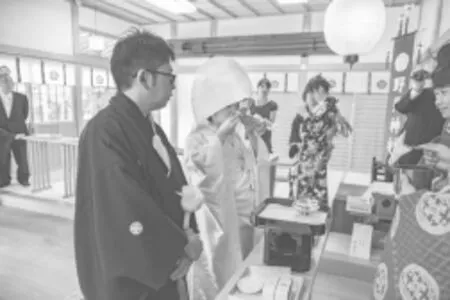
共饮清酒仪式
发源地:日本
在日本人眼中,数字三是神圣的。日本人在婚礼上备有三杯清酒(或米酒),新娘、新郎和双方父母每杯都要喝三小口(九意味着三倍的幸福)。第一杯酒代表参加仪式的三对夫妻,第二杯酒代表人性的三种弱点(贪、嗔、痴),第三杯酒代表从这三种弱点中解脱。
送木雁
起源地:朝鲜
野雁一生只有一个伴侣,因此是婚姻忠贞的重要象征。新郎在婚礼前送给新娘母亲一只木雁,寓意为承诺对新娘终身保持忠贞。在过去,新郎送的通常是活野雁。新郎在婚礼前会被男方亲友团“揍一顿”,这就是打脚掌(也被称为笞跖刑或falaka)。伴郎用藤杖抽打新郎的光脚掌,据说这是为了考验新郎的体力和品性。
打脚掌
起源地:韩国
按照韩国传统婚礼习俗,
The art of henna
Origin: India
These ornate temporary designs are applied to the hands and feet of the bride, as well as her female friends and family members. And they’re not just decorative: The mahogany-hued dye has been used since ancient times to increase the flow of blessings to the couple. The stain is typically applied as a sacred ritual that begins two days before the wedding. Traditional henna9henna一种使用纯天然植物指甲花的叶或幼苗磨成的糊状颜料在手掌、手背等部位绘制的短时间保存的人体绘画。tattoos include dedications to Hindu gods and goddesses and depictions of sacred symbols; today, brides and grooms often meld10meld结合。the name of their beloved into the intricate artwork.
彩绘艺术
起源地:印度
新娘以及新娘的女性朋友和女性家庭成员的双手双脚都要涂上这种临时的装饰图案。这些彩绘不只是装饰,红褐色的指甲花染料自古就用来为新婚夫妇祈福。这种彩绘纹身是非常神圣的仪式,通常在婚礼前两天就开始进行了。传统的指甲花染料纹身包括向印度教男女众神表达敬意的图案和神圣符号。今天,新娘新郎通常把对方的名字融进繁复的彩绘图案里。
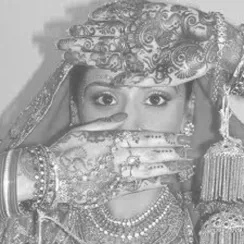
Ransom for the shoes
Origin: Pakistan
After a Pakistani wedding, the couple returns home for a ceremony called the “showing of the face.” Family and friends hold a green shawl over the couple’s heads and a mirror as the bride removes the veil she wears throughout the wedding ceremony. While the newlyweds are busy gazing at one another,the bride’s female relatives make off with the groom’s shoes and demand money for their safe return.
Royalty for a day
Origin: Malaysia
All brides hope to be treated like royalty on their big day, but Malaysian brides actual are. During Malay weddings, traditions of the royal court are observed11observe庆祝;庆贺。with Malay court music played during the ceremony. Wait staff dressed as court attendants serve the newlyweds and those impersonating12impersonate扮演。royal guards perform traditional martial arts.
Connecting with all five senses in the Andes Mountains
Origin: Peru
The Andean wedding is illustrative of local customs. The bride and groom enter a garden from opposite sides, to represent the coming together of people from different villages. A shaman1313 shaman萨满(据信能和善恶神灵沟通,能治病的人)。awaits their arrival, while chanting a blessing. There is also intense, rhythmic music playing. There is a scent of burning herbs, and the shaman poured oil down the backs of their necks, to elicit physical sensation. Everything is designed to overwhelm the senses—sight, hearing, touch and scent. The bride and groom give offerings to each other, and bury a joint offering to Pachamama14大地之母:安第斯地区印加人信仰中的生育女神,掌管种植和收获。, which is meant to be there waiting for her, underground, until the end of time.
赎鞋
起源地:巴基斯坦
巴基斯坦人的婚礼结束后,新婚夫妇会回到家中,举行被称为“揭面纱”的仪式。在新娘揭开婚礼全程所戴的面纱时,亲友们在新婚夫妇头顶上方撑起一块绿色披巾并用一面镜子照着。当新郎新娘互相深情凝望时,新娘的女性亲属就会拿走新郎的鞋子,新郎得交付赎金才能要回鞋子。
做一天皇族
起源地:马来西亚
所有的新娘都希望自己在大喜之日能得到像皇族一样的待遇,只有马来西亚的新娘能如愿以偿。马来西亚人的婚礼遵循皇室传统,仪式从始至终播放马来西亚皇室音乐。婚礼上服务人员穿戴成皇室侍从的样子,供新婚夫妇差遣,还有人模仿皇室卫队表演传统武术。
在安第斯山脉连通五感
起源地:秘鲁
安第斯地区的婚礼极具地方特色。新郎和新娘分别从正对的两边走进花园,代表来自不同村落的两个人结合在一起。萨满在花园里一边等着新郎新娘到来,一边为他们吟唱祈福。婚礼上还会有热烈欢快的音乐、燃烧药草的香味。萨满把一种油浇倒在新郎新娘颈后,触发他们身体的感觉。做这一切是为了唤醒视觉、听觉、触觉和嗅觉等感官。新婚夫妇会互赠祭品,并把共同献给“大地之母”的祭品埋入地下,这样,直至地老天荒,“大地之母”都可享用祭品。
12 symbols of life
Origin: South Africa
South African weddings are steeped in15be steeped in深深浸淫;饱含(某品质)。ancient tradition. Twelve symbols,meant to represent the couple’s life together, must be present at every ceremony. These include wine, wheat, a broom, honey, bitter herbs, salt, pepper,a spoon, spear, a cooking pot, and a shield, plus a holy book, such as a Bible or Koran. In addition to the 12 symbols of life, the bride and groom ceremoniously have their wrists tied together with grass, to symbolize their coming together as a couple. ■
12件象征生活方方面面的物品
起源地:南非
南非人的婚礼充溢着古老的传统元素。每个仪式上必须有12件物品,代表新婚夫妇未来共同的生活。这些物品包括酒、小麦、一把扫帚、蜂蜜、苦药草、盐、胡椒、一把勺、矛、一口锅、一面盾,以及经书,比如《圣经》或《古兰经》。除12件生活物品外,新郎新娘还会进行一种仪式,用草结环把两人手腕缠在一起,象征他们正式结为夫妇。 □
tie the knot〈习语〉结婚。

